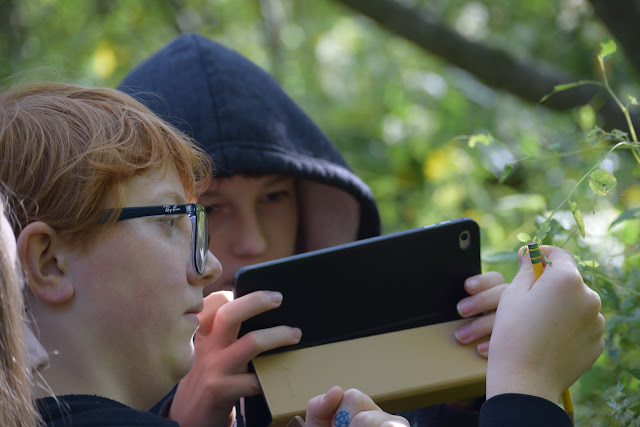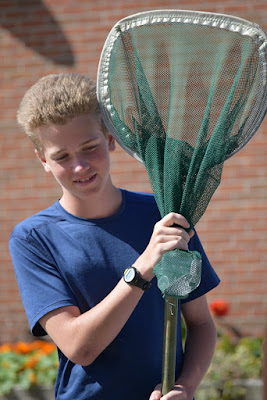Camels Hump Middle School held its first annual BioBlitz in Richmond, Vermont on September 18 &19.
They joined other schools participating in the 2019 Vermont Alliance for Half-Earth School BioBlitz.
What is a BioBlitz? A BioBlitz is a celebration of *biodiversity. The goal of a bioblitz is to find as many species as possible in a specific area over a short period of time.
*Biodiversity: The totality of genetic variation that you find in organisms. Human activity puts us at risk of losing as much as half of those organisms by the end of this century. We need these creatures for stability on earth.

 Why do a Bioblitz? To connect students to the natural world, engage participants in an immersive exploration of their local biodiversity, and promote awareness of the importance of understanding the natural world. Participants learned techniques for observing and collecting plant, animal, and fungi data within a designated area and time frame. Students learned identification tips, practiced with fieldwork tools, including binoculars, field guides, microscopes, and nets.
Why do a Bioblitz? To connect students to the natural world, engage participants in an immersive exploration of their local biodiversity, and promote awareness of the importance of understanding the natural world. Participants learned techniques for observing and collecting plant, animal, and fungi data within a designated area and time frame. Students learned identification tips, practiced with fieldwork tools, including binoculars, field guides, microscopes, and nets. 

Why else? Because we value our sense of place and all that is alive within it. We are motivated by the project's mission and goals as well as the scientific findings from each of our individual contributions. Moreover, hands-on citizen science combines high-quality scientific activity with building and maintaining social relationships. * From "What motivates people to Join...".
 Location: Designated areas within RES, CHMS, and Willis Land Preserve properties.
Location: Designated areas within RES, CHMS, and Willis Land Preserve properties.
Who participated? 7th and 8th-grade students, teachers, naturalists, and volunteers.

Prior to Wednesday and Thursday, students learned about E.O. Wilson's Half-EarthProject, the importance of preserving biodiversity, the purpose of a BioBlitz, tips for collecting data, and how to upload findings into iNaturalist through a viewing of E.O. Wilson Introduction & BioBlitz Overview.
 What happened at the survey sites? Volunteers joined the teachers to support students in observing and
photographing living organisms. Each "survey team"
set out to search for as many species as they could find. They collected samples, took photographs, identified species by common or scientific name, and noted the location.
What happened at the survey sites? Volunteers joined the teachers to support students in observing and
photographing living organisms. Each "survey team"
set out to search for as many species as they could find. They collected samples, took photographs, identified species by common or scientific name, and noted the location.


The groups traversed a variety of terrain: thickets,
 meadows, streams,
wetlands, and wooded. Teachers stressed the importance of
focus, respect, safety, and fun. The goal was to inventory all the living
organisms on campus in a two-day period.
meadows, streams,
wetlands, and wooded. Teachers stressed the importance of
focus, respect, safety, and fun. The goal was to inventory all the living
organisms on campus in a two-day period.
















Let's take a moment to read an account from two of the students.
BioBlitz at Camels Hump Middle School
By Indira Bush and Rosa Ricketson
7th Grade Students Team Sequoia
Camels Hump Middle School
Richmond, Vermont
 When seventh-grade Sequoia science teacher, Sandra Fary, at Camels Hump Middle School (CHMS), first told her students that they would be participating in a Bioblitz, they had a variety of responses. Some were positive; others were negative. One student even thought it would be a mix of pandemonium and soggy, moody, teenagers that would be released into the wild. They didn’t know if their groups would work, or if they could actually find anything on the CHMS campus and adjoining sites. Others were excited to be outside or to learn how to identify new species. One student said, “I was excited because I got to go outside and explore new places I wouldn’t have even thought about going to if I didn’t do this.” Overall, many students were thrilled at the opportunity to learn in an outside, rather than inside, classroom.
When seventh-grade Sequoia science teacher, Sandra Fary, at Camels Hump Middle School (CHMS), first told her students that they would be participating in a Bioblitz, they had a variety of responses. Some were positive; others were negative. One student even thought it would be a mix of pandemonium and soggy, moody, teenagers that would be released into the wild. They didn’t know if their groups would work, or if they could actually find anything on the CHMS campus and adjoining sites. Others were excited to be outside or to learn how to identify new species. One student said, “I was excited because I got to go outside and explore new places I wouldn’t have even thought about going to if I didn’t do this.” Overall, many students were thrilled at the opportunity to learn in an outside, rather than inside, classroom.
If you’re wondering what a bioblitz is, here’s the short answer: a Bioblitz is when you go out into the natural world for a given amount of time and inventory every biotic organism in that area. Students from teams Spark, Grit, and Sequoia at CHMS were split into groups and each was scattered around the CHMS, Richmond Elementary School, and Willis Land Preserve areas to inventory life in different habitats. The bioblitz went extremely well and between the teams, students made 437 observations and found 168 different species of animals, plants, and fungi on the CHMS campus.
CHMS wasn’t the only school that participated in this bioblitz. There were nine other schools within the Winooski River Watershed that inventoried their campuses. Combined, the schools made 2,516 observations and found 558 species. This gave us a great sense of the biodiversity within our local watershed.
Why is a Bioblitz important? Conserving biodiversity. The dictionary defines biodiverse as, “The variety of life in the world or in a particular habitat or ecosystem.” However, biodiversity is under attack. According to Half-Earth, a project working to defend biodiversity, it says, “When 90% of a habitat is removed, the number of species that can persist sustainably will descend to about a half.” To put that in perspective, that’s like if a class with 24 kids lost 90% of their classroom space, because of the decrease in space, only 12 students would be able to continue their learning in that classroom. Half-Earth is dedicated to protecting biodiversity.
 It all started on two hot days. We all walked out in the early morning to see what we were facing and collect some supplies we might need. Armed with sweeper nets, bug jars, magnifying glasses, and datasheets, each group and their chaperone went to their assigned spot. From there they began to record every living organism (plants, fungi, and animals) that they could find. Then, the data sheets started to fill up.
It all started on two hot days. We all walked out in the early morning to see what we were facing and collect some supplies we might need. Armed with sweeper nets, bug jars, magnifying glasses, and datasheets, each group and their chaperone went to their assigned spot. From there they began to record every living organism (plants, fungi, and animals) that they could find. Then, the data sheets started to fill up.  When we asked Sequoia students what their favorite part of the bioblitz was, one kid said, "I really liked finding cool plants that I had never seen before." Another boblitzer said, "My favorite part was when I found a whole bunch of black and yellow garden spiders." This just goes to show that the students that participated had a lot of fun during this two-day event! Additionally, when asked, 70 % of the Sequoia students answered that they would rate their experience as fun or awesome.
When we asked Sequoia students what their favorite part of the bioblitz was, one kid said, "I really liked finding cool plants that I had never seen before." Another boblitzer said, "My favorite part was when I found a whole bunch of black and yellow garden spiders." This just goes to show that the students that participated had a lot of fun during this two-day event! Additionally, when asked, 70 % of the Sequoia students answered that they would rate their experience as fun or awesome. However, the fun was rooted in learning. One participant shared their excitement over learning how to tell if the tree is a beech tree just by the feel of the leaves. Others liked learning to use iNaturalist. Some exciting finds included dragonfly larvae, birds’ nests, a juvenile trout, a tree frog, a polyphemus moth caterpillar, and many more.
However, the fun was rooted in learning. One participant shared their excitement over learning how to tell if the tree is a beech tree just by the feel of the leaves. Others liked learning to use iNaturalist. Some exciting finds included dragonfly larvae, birds’ nests, a juvenile trout, a tree frog, a polyphemus moth caterpillar, and many more.
How can you help? The Half-Earth Project was created a few years ago and it strives towards the goal of conserving half of all the oceans and land. To help get an understanding of the biodiversity of the earth, you can do your own bioblitz at home, work, or school! To start, you can download iNaturalist. iNaturalist is a free app that allows you to take pictures of cool organisms you find and identify them. iNaturalist also allows you to see what other people found near you! Once you have the app, just take some time out of your day to find something interesting in the natural world. Encourage others to get involved.
As new seventh graders who were jumbled up with new kids, it was a great way to get to know our new classmates and the natural world around us. In conclusion, we learned a lot during the two days that we participated in the bioblitz, not only about our natural ecosystem but about working together and completing research. One kid described it as "THE BEST THING I HAVE DONE ON SCHOOL GROUNDS EVER!!!!!
next fall. We need volunteers! To get involved you can (we need it!) contact Camels Hump Middle School and get your sweep nets ready!












Many samples were brought back for all participants to view.

















The whiteboard gives a partial account of the number of species viewed and recorded.

Camels Hump Middle School Results:
437 Observations
168 Species
View the CHMS details on iNaturalist at https://www.inaturalist.org/projects/camels-hump-middle-school-2019-vermont-alliance-for-half-earth-school-bioblitz?tab=stats
And view the final number from other schools in the project here https://www.inaturalist.org/projects/2019-vermont-alliance-for-half-earth-school-bioblitz
What happened after the Bioblitz?

Back in the classroom, students uploaded their findings to iNaturalist. Teams will generate maps, create artwork, craft poetry, or write an article for local papers.
Coordinators of the event: Teachers, Sandra Fary (Grade 7), David Jensen, and Anna Kovaliv (Grade 8).
Thank You to Sean Beckett and Nathaniel Sharp, project administrators at the North Branch Nature Center in collaboration with Vermont Center for Ecostudies. These two organizations sponsored BioBlitzes in more than ten schools from Burlington to Plainfield. In order "To introduce students to the vital role biodiversity plays in healthy ecosystems and get them thinking about what can be done on school property to provide better habitat for Vermont species..." Quote from iNatuarlist posting.
Read more about citizen science programs that you can join at my Citizen Science posting.
Jericho Vermont
Images of CommunityIntimate, caring, and personal; reflecting the community and its stories.
Bernie Paquette







No comments:
Post a Comment